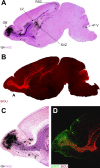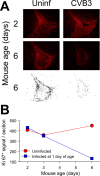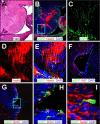Coxsackievirus targets proliferating neuronal progenitor cells in the neonatal CNS
- PMID: 15745971
- PMCID: PMC6726081
- DOI: 10.1523/JNEUROSCI.4517-04.2005
Coxsackievirus targets proliferating neuronal progenitor cells in the neonatal CNS
Abstract
Type B coxsackieviruses (CVB) frequently infect the CNS and, together with other enteroviruses, are the most common cause of viral meningitis in humans. Newborn infants are particularly vulnerable, and CVB also can infect the fetus, leading to mortality, or to neurodevelopmental defects in surviving infants. Using a mouse model of neonatal CVB infection, we previously demonstrated that coxsackievirus B3 (CVB3) could infect neuronal progenitor cells in the subventricular zone (SVZ). Here we extend these findings, and we show that CVB3 targets actively proliferating (bromodeoxyuridine+, Ki67+) cells in the SVZ, including type B and type A stem cells. However, infected cells exiting the SVZ have lost their proliferative capacity, in contrast to their uninfected companions. Despite being proliferation deficient, the infected neuronal precursors could migrate along the rostral migratory stream and radial glia, to reach their final destinations in the olfactory bulb or cerebral cortex. Furthermore, infection did not prevent cell differentiation, as determined by cellular morphology and the expression of maturation markers. These data lead us to propose a model of CVB infection of the developing CNS, which may explain the neurodevelopmental defects that result from fetal infection.
Figures









Similar articles
-
Coxsackievirus B3 and the neonatal CNS: the roles of stem cells, developing neurons, and apoptosis in infection, viral dissemination, and disease.Am J Pathol. 2003 Oct;163(4):1379-93. doi: 10.1016/S0002-9440(10)63496-7. Am J Pathol. 2003. PMID: 14507646 Free PMC article.
-
Chain formation and glial tube assembly in the shift from neonatal to adult subventricular zone of the rodent forebrain.J Comp Neurol. 2005 Jul 11;487(4):407-27. doi: 10.1002/cne.20576. J Comp Neurol. 2005. PMID: 15906315
-
Expression of trophinin and bystin identifies distinct cell types in the germinal zones of adult rat brain.Eur J Neurosci. 2006 May;23(9):2265-76. doi: 10.1111/j.1460-9568.2006.04782.x. Eur J Neurosci. 2006. PMID: 16706835
-
Coxsackie B virus and its interaction with permissive host cells.Clin Diagn Virol. 1998 Apr;9(2-3):115-23. doi: 10.1016/s0928-0197(98)00010-5. Clin Diagn Virol. 1998. PMID: 9645993 Review.
-
Research progress and application prospects of animal models of group B Coxsackievirus infections.Emerg Microbes Infect. 2025 Dec;14(1):2441391. doi: 10.1080/22221751.2024.2441391. Epub 2024 Dec 22. Emerg Microbes Infect. 2025. PMID: 39665300 Free PMC article. Review.
Cited by
-
Activation of type I interferon antiviral response in human neural stem cells.Stem Cell Res Ther. 2019 Dec 16;10(1):387. doi: 10.1186/s13287-019-1521-5. Stem Cell Res Ther. 2019. PMID: 31843025 Free PMC article.
-
Susceptibility of human embryonic stem cell-derived neural cells to Japanese encephalitis virus infection.PLoS One. 2014 Dec 17;9(12):e114990. doi: 10.1371/journal.pone.0114990. eCollection 2014. PLoS One. 2014. PMID: 25517725 Free PMC article.
-
Spongiform degeneration induced by neuropathogenic murine coronavirus infection.Pathol Int. 2011 Apr;61(4):184-91. doi: 10.1111/j.1440-1827.2010.02639.x. Epub 2011 Jan 23. Pathol Int. 2011. PMID: 21418390 Free PMC article.
-
Cellular responses to Sindbis virus infection of neural progenitors derived from human embryonic stem cells.BMC Res Notes. 2014 Oct 24;7:757. doi: 10.1186/1756-0500-7-757. BMC Res Notes. 2014. PMID: 25343994 Free PMC article.
-
Coxsackievirus preferentially replicates and induces cytopathic effects in undifferentiated neural progenitor cells.J Virol. 2011 Jun;85(12):5718-32. doi: 10.1128/JVI.02261-10. Epub 2011 Apr 6. J Virol. 2011. PMID: 21471247 Free PMC article.
References
-
- Alvarez-Buylla A, Garcia-Verdugo JM, Tramontin AD (2001) A unified hypothesis on the lineage of neural stem cells. Nat Rev Neurosci 2: 287-293. - PubMed
-
- Daley AJ, Isaacs D, Dwyer DE, Gilbert GL (1998) A cluster of cases of neonatal coxsackievirus B meningitis and myocarditis. J Paediatr Child Health 34: 196-198. - PubMed
-
- Doetsch F (2003) A niche for adult neural stem cells. Curr Opin Genet Dev 13: 543-550. - PubMed
Publication types
MeSH terms
Substances
Grants and funding
LinkOut - more resources
Full Text Sources
Medical
